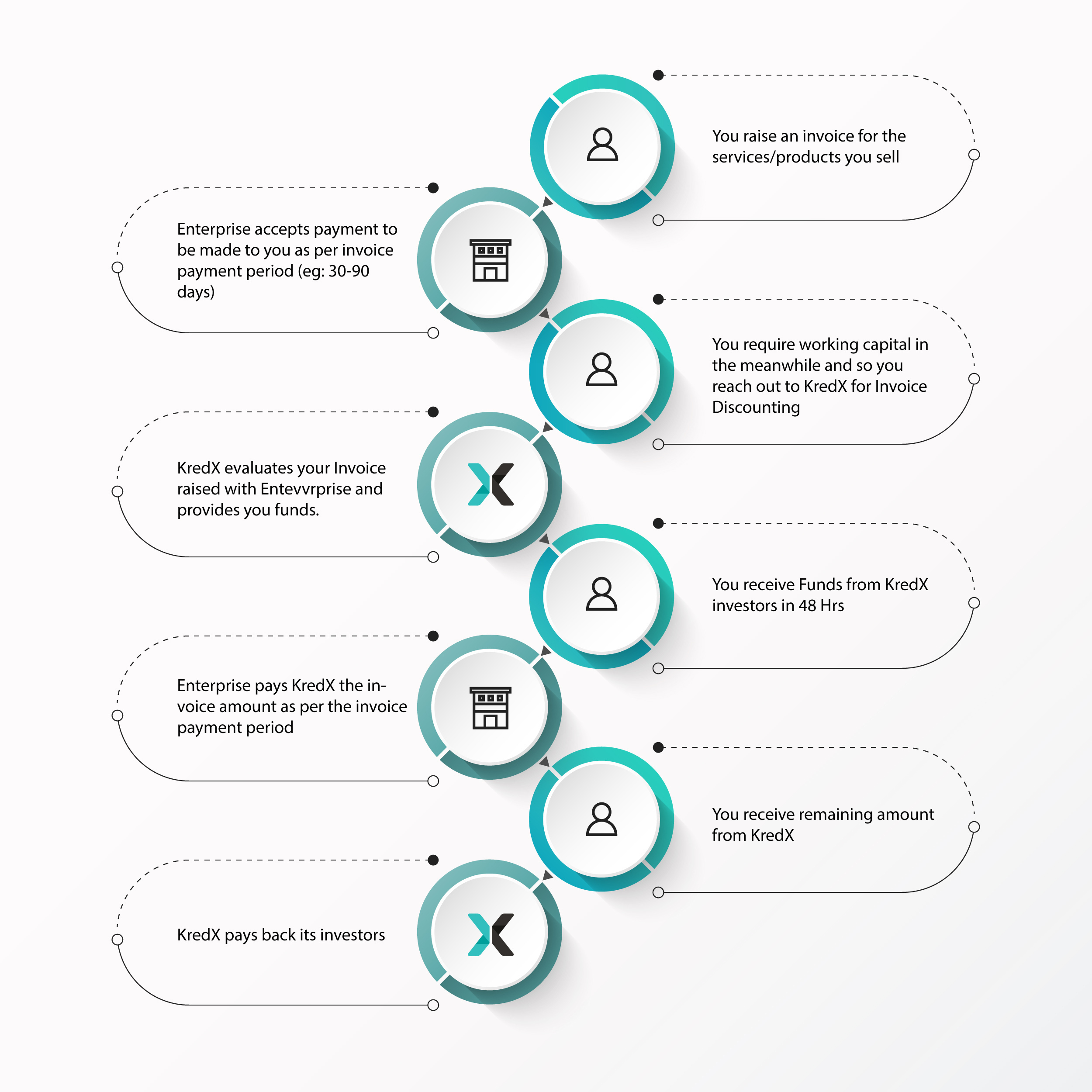Working Capital Calculator
Overcome your Working Capital Challenges with Invoice Discounting
| *Invoice Details for Invoice Discounting with KredX | |
| Invoice Amount for 3 Months | ₹ |
| Invoice Payment Period (in days) | |
| Maximum Amount Disbursed | ₹ |
| Tenure (in days) | |
| Interest Charged | Minimum 12% per annum |
| Interest Paid on Amount | ₹ |
The working capital calculator is an easy-to-use online tool that allows businesses to determine how much surplus cash they need to keep running. Working capital refers to the assets owned by a company against its liabilities and is a measure of its financial health.
Knowing the working capital requirements of one’s company is crucial for making business decisions. Hence, individuals may want to keep track of their business’s cash flow using this free tool.
Table Of Contents :
1) How Invoice Discounting works
2) A Brief Explanation Of Working Capital
3) Working Capital Loan Vs Invoice Discounting
4) How Is Working Capital Calculated?
How Invoice Discounting works?

A Brief Explanation Of Working Capital
Working capital is the money required by a business to run its daily operations, including paying bills, debts, employees’ wages and purchasing raw materials. This financial liquidity indicator is defined as the difference between a company’s current assets and current liabilities.
Working Capital = Current Assets - Current Liabilities
Current assets refer to whatever the company possesses in cash or things it can convert to cash in less than a year. On the other hand, current liabilities refer to a business's total debt, whether interest-bearing (loans) or non-interest bearing (accounts payable).
A positive working capital shows that a company is well-positioned to cover its liabilities and conduct business expansions. However, a negative working capital indicates that the company needs financial assistance very soon. KredX offers invoice discounting to solve working capital problems as businesses can use unpaid invoices that would otherwise be unavailable for their needs.
Working Capital Loan Vs Invoice Discounting:
Traditional financial institutions provide a working capital loan to cover the cost of running a company. One can avail such financing by furnishing details about the purpose of the loan, the company’s balance sheets etc.
On the other hand, invoice discounting is an alternative financing method where businesses can offer their outstanding accounts receivable to get working capital. The following table illustrates some of the differences between the two financing methods.
|
Working Capital Loans |
Invoice Discounting |
|
These funds come with stringent eligibility criteria. |
This is a flexible funding option with a hassle-free application process. |
|
May or may not require collateral |
The unpaid invoices are used as collateral |
|
Long repayment tenure, usually 12, 18 or 24 months |
Has shorter repayment tenure between 30-90 days |
|
These loans appear on the balance sheet as debt. |
No liabilities are added to the balance sheet. |
|
Repayments made in Equated Monthly Instalments (EMIs) |
Have to repay in a lump sum |
How Is Working Capital Calculated?
To calculate the working capital needs, one needs to use the following formula:
Net working Capital = Current Assets – Current Liabilities
Here the working capital calculation considers all sorts of current assets, including savings accounts, stocks, bonds, mutual funds, cash equivalents, inventory items and other short-term prepaid expenses. Current liabilities include rent, accounts payable, cost of utilities, materials and supplies and income taxes.
This value shows how much working capital a business possesses. To know how much funds a company needs to meet short-term debt obligations, one needs to determine the current or working capital ratio.
The following formula is used for the calculation of the current ratio:
Current ratio = Current assets/current liabilities
A ratio around two is considered adequate for optimum performance, although this can vary for different businesses (1). Generally, a working capital ratio below this indicates an inability to pay financial obligations without a degree of safety, while a number well above this indicates poor use of capital.
How To Use KredX Working Capital Calculator?
The online KredX working capital calculator helps businesses determine the amount of working capital they need to smooth out their financial situation. Here is how one can use this calculator to figure out the number:
FAQs
Yes, the KredX working capital calculator is 100% free to use with no limitations, signing up requirements or hidden charges.
No, anyone can use this free tool on our site without requiring them to log in or pay any fee.
The working capital ratio provides a rough idea about how much capital your business requires to keep running. Your business may need more cash depending on its business volume, nature of sales (seasonal or year-round), accounts receivables, inventory turnover rates etc.
You can use your company’s unpaid invoices as security to get invoice discounting from KredX. We offer timely access to capital in just 24 to 72 hours* for up to 90%* of the invoice amount (2).
